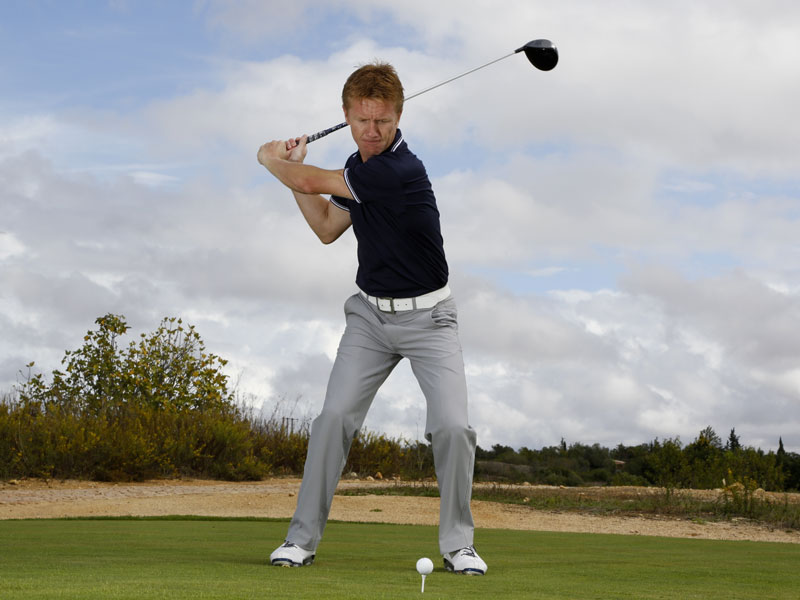Driver Swing Tips
Golf Monthly Top 50 Coach Andrew Jones offers his top driver swing tips to help you hit it longer and straighter


The modern game revolves around power, with advancements in statistical analysis highlighting the many benefits of launching the ball as far as possible off the tee. But it's easier said than done. In the video and article below, Golf Monthly Top 50 Coach Andrew Jones shares five driver swing tips to help you hit it further and find more fairways.
1. Posture & alignment
Every shot you play, from driver to wedge, requires good posture and alignment. But with the longer shaft of the driver in your hands, any mistakes here and the results could be disastrous for your scorecard. The biggest mistake with regards to posture I see is an unathletic ‘C’ shaped spine at address where the pelvis is tucked under. It’s almost impossible to make a powerful swing and get the club working on a good path from here.
Instead, and to kick off my driver swing tips, you should stick your backside out at address to straighten your spine. This is much more dynamic and will enable you to make a good turn and keep the club working on a good path. Also, when you practice, lay a shaft down between your feet and the ball-to-target line. Make sure you set your body square to this shaft and again, you’ll be far more likely to achieve a more effective swing plane.
2. Ball position & weight distribution
With a driver in hand you are looking to strike the ball on the ‘upswing’. To do this you must set the ball forward in your stance – just inside your left heel. This will automatically mean around 70% of your weight will be behind the ball. This is good as it helps initiate the weight transfer into your right side during the backswing that you are looking for – at the top, 90% of your weight should be over your right side. The big mistake to avoid is to have too much weight on your left side with the ball back in your stance. This encourages the opposite weight shift and creates a steep angle of attack that will affect both the quality and accuracy of the strike.
3. Tee height
This is something that is well worth paying attention to. The right tee height doesn’t just help the quality of the strike but will also encourage you to get into the correct position to deliver the club to the ball. Ideally, the middle of the ball should be in line with the top of the driver. This will help you find the right upward angle of attack into the ball for a flight that is long with less backspin for maximum yardage.
4. Swing trigger
One of the biggest killers for both power and accuracy off the tee is tension. When you take your address position and look up only to see trees and bunkers lining the fairway, it is very difficult to stay relaxed. But tension in your grip and forearms will kill the fluidity and rhythm of your swing. To avoid this, you need to keep moving. You can either hover the club at address or, what I do is waggle the club and then employ a swing trigger. For me, that’s addressing the ball from the toe of the club and then sliding it into position. This ‘slide’ is the trigger for me and once the middle of the club is behind the ball, I start the swing – no hesitations. This works really well as a simple pre-shot routine. It clears your mind and keeps tension at bay. Give it a try!
5. Passive takeaway
The takeaway is a crucial move. Get it right and you’ll start the club working on a good path, get it wrong and you’ll need to make compensations in the swing to find a good strike and this will usually create either slice or hook spin. To help, place your hands on the club, just below the grip. As you take the club away, the butt end of the club should stay pointing at your stomach. If you find it pointing right or left of you, your takeaway contains an unnecessary early wrist hinge that could be hurting you. Use this drill to get yourself back on track.
Subscribe to the Golf Monthly newsletter to stay up to date with all the latest tour news, equipment news, reviews, head-to-heads and buyer’s guides from our team of experienced experts.

Location: Walmer & Kingsdown Golf Club
After turning professional in 1991, Andrew served as Assistant Pro at Royal Cinque Ports from 1993 until 1998, before spending three years as Head Pro at Lydd Golf Club. He remains in Kent and, after a spell as the Director of Coaching at Sene Valley, is now the Club Professional at Walmer & Kingsdown Golf Club.
Students learn best when...
They have bought into your vision, passion and enthusiasm as a coach and are prepared to go on the journey with you sharing experiences and opinions with an open mind to what is necessary to improve their game. Both the pupil and the coach need to be entering this relationship with eyes, ears and senses wide open and a willingness give it a go!
Greatest teaching influence:
Fellow Top 50 coach, former boss and mentor, Andrew Reynolds. In my early years as a trainee PGA assistant at Royal Cinque Ports, he instilled in me the importance of the analysis of ball flight and also identifying cause and effect within the swing. Other notable (Tour) coaches I have studied carefully during my development have been David Leadbetter and Butch Harmon.
Most common problem:
The grip. For me, it has to be the poor connection to the club itself that can have a fundamental and sometimes catastrophic influence on how we stand to, move and deliver the club to the ball.